by Marion Patterson | Nov 26, 2020 | (Sub)Urban Homesteading, Energy Efficiency
Many people cringe when the monthly electric bill arrives. Not us. In 2019 the average homeowner in the United States paid $115 a month. Our last bill was $13. That is right! Thirteen bucks. Almost everyone can tame their electric bill. Here’s how we did it:
- Replaced incandescent and compact fluorescent bulbs with LED (Light Emitting Diode) bulbs. They last almost forever and only use about a fifth the electricity of incandescents. LED bulbs were once expensive but now are as low as $1 each.
- Purchased high-efficiency Energy Star Rated appliances. Yes, you pay more upfront. The savings are significant over time.
- Turn it off! The human index finger has enormous bill cutting power and is free. If a light, television, computer, or any other power-consuming device is not being used…. we turn it off. Remember many of today’s appliances are “vampires.” All those glowing lights on appliances collectively suck energy and balloon your bill. Some you cannot unplug or turn off. Others you can.
- Avoid night lighting. Our outdoor lights stay “off” unless we need them briefly for outdoor work. Use motion light sensors if you think you need to be aware of outside activity at night.
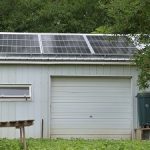
Soaking up the sun.
After completing the above steps, we installed photovoltaics on the barn’s roof. Photovoltaics (PV) are panels that use the sun’s energy to create electricity. Electricity generated by our small system partially powers our home’s needs. When we produce more than we’re using it flows out to the power grid. When we’re using more than we make, which always happens at night, grid power flows in. At the end of the month, we pay the “net”. Because our system is small, over time we never produce as much electricity as we use, but we make most of it. Combined with efficiency we tamed our electric bill.
The Federal Government and many states offer tax credits to homeowners who install solar. The value of credits diminishes each year, so acting soon maximizes tax savings and tames electric bills. It’s a great time to “go solar”.
by Winding Pathways | Nov 19, 2020 | (Sub)Urban Homesteading, Reflections/Profiles
Guest Bloggers Share Their Memories of Past Autumns
We invited readers to share their fall traditions and memories with Winding Pathways to help us through the 2020 Autumn and Holiday/Holy Days season.
Flowers For Fall

Chrysanthemums bring joy.
JH- “Every year I tend lovingly to a patch of chrysanthemums that I planted many moons ago in my vegetable garden. It has a place of importance along with my four lilies in this particular raised bed. This plant sprouts in spring and gradually makes
its way skyward until the September coolness brings teeny tiny buds which become a single petaled soft orange sherbert color. I always leave the seed stalks during the winter because I know that birds love the seeds. A sense of peace and joy washes over me as this patch sallies forth in the fall. The bees and butterflies love it as well.
Soon the cold of winter will send it into its deep sleep to wait for another year of gorgeous blossoms.”
Family Gatherings

Extended family
SF- “Many T-givings we spent at Grammy’s. Everyone sat around the table, Gram at one end, Grandpa at the other. Gram served up the potatoes and veggies, she then passed the plates along down the line to Grampa who put the meat on then it was passed down the other side. Each of us, uncles and aunts, got our meals. Gram always loaded our plates which was always too much for us kids. One year Gram said something to us that she was tired of us not eating all our food and she was tired of throwing away good food. Mum stood up and told her we served ourselves at home and we’re expected to eat what we were given. At subsequent T-givings Gram would ask us how much we wanted and then ate what she gave us. After Grammy passed away usually Aunt Bunny and Uncle Joe came for T-giving at our house on Tibbetts Hill. Uncle Joe was always fun.” Editor’s note: The family later hosted extended family Thanksgivings at their New Hampshire homestead.
***
Loving the Amanas

Special time with Pops.
KT – “I miss going to the Amana’s with my father. He has passed and while he hated the changing of the seasons to cold weather, he loved eating and visiting the Amanas with his grandchildren. We always started with breakfast at the Colony Inn. For the best thin pancakes and sorghum, along with fresh fried potatoes, eggs, and English muffin toast with homemade strawberry jam. Then we had to head to the General Store for candy purchases usually Swedish fish, Rock Candy, and Red Licorice. If we had visitors with us we would tour the Woolen Mills and the Furniture Store and of course the Christmas Store with the most beautiful decorations.
“The Amanas is the closest thing we have to a fun Oktoberfest setting and environment. Such a great little historic village with many family memories for me!” Editor’s note: The girls are grown now. One lives in Nashville and the other attends Luther College.
Day Trips
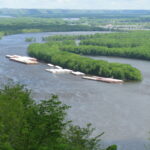
The Mississippi River stretches from Minnesota to the Gulf Coast.
S&MN – “Each fall, we would invite a couple of language teaching assistants, recently arrived in Minnesota from France to a ride down the Mississippi River to view the changing colors of the leaves. Conversation on the ride to Wisconsin gave us a chance to learn more about each of them and their first impressions of their stay in the US. We would follow the Mississippi River down the Wisconsin side to Stockholm, Wisconsin, where we would lunch at a small cafe, visit the Amish quilt shop, gift shops, and antique stores. This included touring a small museum of the original post office.
Conversation Openers
We would stop at the scenic Maiden Rock overlook and Lake Pepin. Did you know that Water Skis were invented there? We’d take in the Laura Ingalls Wilder Museum in Pepin, Wisconsin, and visit the replica of the Little House in the Big Woods. We shared stories and explained about the Little House book and movie series as we could. We loved making connections to life in France during the same time period of the 1870s and learning which facts were most interesting to the young interns who had read the book series in France. Thirty years ago, the language assistants would have been fans of the TV series by the same name La Petite Maison Sur La Prairie. It was a popular series on television in France. In recent years, the students would have been given details learned on the show by their mothers who had loved the show as children.
Conversations on the way back to the Twin Cities would be filled with questions that were often spurred by what we saw and that most usually unanswered. These conversations provided us with opportunities for conversation topics in the months that followed as many were inspired to read the series in English during their stay after the visit.”
Saint Paul Intercultural Institute
***
New Adventures for a New Englander
SH – “The first autumn after we moved to Wisconsin from New Hampshire I had a wonderful introduction to the fall bird and waterfowl migration. I had never experienced anything like it.
Horicon Marsh is huge! Part of it is federal lands and part is state lands. I was not sure what to expect when it was suggested that we join my husband’s parents for a Sunday outing. I was totally amazed and awed at the sheer numbers of birds that were flying, landing, and swimming in the water. A busy main state highway that runs across the top area of the marsh. Lots and lots of cars were parked on the edges of the road with families, watching out for traffic. People were wandering about taking in the sights.
When our daughters were young, we made sure that they also had the opportunity to see this mighty spectacle. I still enjoy going across that state highway and exploring the area. A recent addition is a park-like area with a paved one-way auto road with pull-outs and informational signage. Trails to hike and a boardwalk that has a gazebo with scopes get visitors out into the marsh for better viewing. There are also various dykes and dirt roads to boat landings to explore. After the autumn rush of migration, it is still a fun place to visit, and so far no matter when we visit, I have never been disappointed. It seems like we are always able to find some wildlife and sometimes get great photos of birds we don’t see on a regular basis.”
Paranormal
SBF – “When I bought a house in FL her son told me that the lady who had lived there before had loved her house and property very much. After I moved in with my friend, Jinx, on several nights I awoke to the TV sounds in the family room so I would go turn it off. This went on for 3-4 nights. Finally, on the fifth night I turned it off once more, but I stood by it and spoke to the previous owner. I told her I loved the house and lovely plants around it, a ginger bush, a beautiful poinsettia bush, and a pretty plant on the backyard fence. Then I promised I would try to care for them as best as I could. “But please,” I asked, “could you not turn on the TV after we go to bed at night as I had to get up to go to work 5 days a week.”
The TV never went on at night after that!”
Thanks for sharing autumn stories!
by Winding Pathways | Oct 22, 2020 | (Sub)Urban Homesteading, Mammals, Pests
Early one September morning a disturbing sight greeted us. The metal post holding a suet feeder high off the ground was bent. The feeder was gone. After a search we finally found it where our nocturnal thieves had abandoned it after devouring the suet.
Many people are frustrated when daytime squirrels gobble up feeder seed, but other mammals visit feeders unseen after sunset. Not all are as rough on feeders as raccoons and all night visitors are interesting but they can also be frustrating.
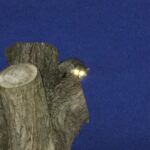
Raccoons are strong and hungry.
Up in the wee hours sleepless or just to get a snack? Shine a flashlight beam on the feeder. You may spot raccoons, deer, flying squirrels, or even a bear! They all like birdseed and some relish suet.
Raccoons live nearly everywhere, even in big cities. Our son once sent a picture he took of one raiding a dumpster in New York City. Occasionally they are out on cloudy days but mostly they are nocturnal.
Raccoons are common, numerous, powerful, and gregarious. Sometimes a whole family visits a feeder after dark. Excellent climbers, if they can’t shinny up a slippery metal pole to reach seed, they might just bend it over as they did at Winding Pathways. They love suet but also eat corn, sunflower seeds, and many other foods people put out for birds.
One of the most endearing animals to visit feeders are flying squirrels. There are two species but both are nocturnal and are almost never seen during daylight. Flying squirrels often live in big dead hollow trees and are more common than most people realize.
Flying squirrels are misnamed mammals. They can’t fly. They should be called gliding squirrels, for they spread loose skin on their sides and glide from the top of a tree to the ground – or bird feeder. These mammals weigh only about two ounces, about half that of an Eastern chipmunk. In comparison, a mature gray squirrel is ten times heavier at about 20 ounces.
Flying squirrels are shy and beautiful. Seeing one is a thrill.
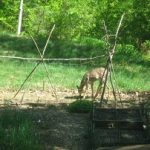
Deer In Garden Photo by S. Fehsinger
Like raccoons and flying squirrels, deer love birdseed. Sometimes they visit during the day but we see them more often after dark. If a feeder is well seed stocked in the evening but is empty come morning deer are likely culprits. Look for their tracks and droppings to confirm the visit.
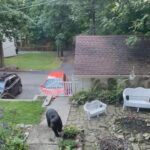
Bears make themselves at home anywhere.
Bears
Gads. Bears at the feeder! Could be. We don’t live in bear country but they are common over much of the United States. Mostly nocturnal, they love birdseed and suet. A 300-pound bear can rip down the most armored feeder and they’re skilled trash can scroungers as well.
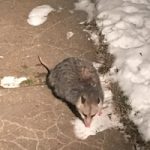
A ‘possum snuffling for food. Photo J. Jones
Skunks, Possums, and Rats
Skunks, opossums, and Norway Rats all love birdseed. Like flying squirrels and raccoons, they are nocturnal. Skunks and possums are native animals that can be comical, but no one wants rats around. They are dangerous pests capable of spreading disease and gnawing on houses.
REDUCING NOCTURNAL FEEDER VISITORS
There’s an effective way to discourage nocturnal feeding wildlife. It’s a two-step process:
- Only put out the amount of seed birds are likely to eat in a day. Empty feeders may attract nocturnal animals but pickings are slim and discouraging.
- Better yet bring all feeders inside by sunset. Store them overnight in a metal trash can with a tight-fitting lid to keep mice from being tempted to raid it even if it’s indoors.
Feeding birds is entertaining and educational. We love having colorful activity just outside our window. We’re not thrilled when raccoons tear up the feeders, so when midnight raiders help themselves, we bring feeders in each evening.
by Winding Pathways | Oct 8, 2020 | (Sub)Urban Homesteading, Birds, Garden/Yard, Nature
The August 10 derecho changed Cedar Rapids, and Winding Pathways wasn’t spared. We lost 47 of our 53 large trees during the 40-minute windstorm. It greatly altered our restoration plans. Here’s what we did or plan to do in response to the loss of trees.
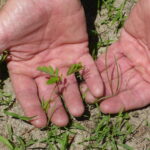
Prairie plant
New prairie plot: We planted this in early May. As expected, we only saw a glimpse of prairie plants in its first growing season, although early prairie plants give us promise that many more will appear next year. We will try to burn it either this fall or early next spring.
The derecho helped the prairie by felling or breaking four Douglas firs, one black oak, and one green ash. Two of these trees cast some morning shade on the prairie. The rest shaded it some in the late afternoon. They’re gone, so the site will enjoy more sunshine, and prairie loves sun. We mourned the tree loss but the prairie will benefit.
The trees didn’t go easily. Several tumbled into the prairie. They were big and filled with branches, leaves, and needles. We prioritized removing them. Many chainsaw and brush hauling hours later we had the trees moved into a big brush pile in the back. The sun now shines on the prairie planting. We’ll keep you posted.
-
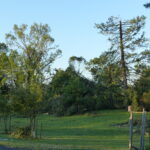
-
The firs and oak smothered the emerging prairie.
-
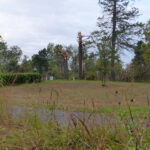
-
The firs shaded the prairie. Now more sun will shine.
Derecho Creates Opportunity
After we cleared fallen trees from the prairie, we turned to many trees that tumbled down on the north and east ends of our land. It’s taken hours to cut shattered trees and cut pathways through fallen logs so we can walk our own land easily. This land was once shady. Now the sun hits the ground. The storm transitioned the land from dense forest to savanna – a landscape of occasional trees and rich plant growth hugging the ground. Wildlife will transition as the habitat changes. Because of this change in the forest, some bird species may decline temporarily and others will thrive.
Open woodland birds: Robins, cardinals, white-eyed vireos, flickers, and Downey, red-bellied, and red-headed woodpeckers.
Mature forest birds: Scarlet tanagers, ovenbirds, wood thrushes, and pileated and hairy woodpeckers.
Shade and Sunshine
We didn’t lose all our forest trees. Just most of them. The loss of shade creates opportunities for ground-hugging plants to thrive, including baby trees. We’re already found some tiny black raspberry plants growing and many oak and hackberry seedlings.
To make sure that appropriate native savanna plants establish in the now sunny areas we ordered a native seed mix from Pheasants Forever that we’ll plant this fall.
We will keep you posted on changes in our prairies and new savanna.
by Winding Pathways | Oct 1, 2020 | (Sub)Urban Homesteading, Birds, Mammals, Nature
We’ll remember August 10, 2020, forever. On that day the wind changed Eastern Iowa and Winding Pathways in a way that will persist for a century. In 40 minutes, straight-line wind gusts up to 140 miles an hour toppled or broke 47 of our 53 trees. Two landed on our roof.
Our property adjoins Faulkes Heritage Woods, a 110-acre preserve of tall old trees, mostly oaks. The derecho felled most of its big trees that tumbled into a jumbled mass of trunks, branches, and leaves.
-
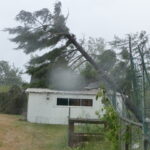
-
The pine toppled onto the cabin roof.
-
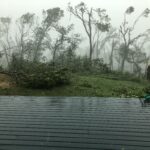
-
Effects of straight-line winds.
-
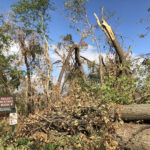
-
Twisted trees.
Wondering how the great change would impact wildlife, we quickly noticed two short term impacts. August and September are usually slow months for bird feeder visitors as birds normally have plenty of wild food. As soon as the wind calmed, all was still. Faithfully, Rich found and filled the feeders. The next morning, we noticed heavy use by house finches, titmice, nuthatches, cardinals, woodpeckers, and chickadees. It was almost like the feeding frenzy that happens as a winter blizzard approaches.
Short Term Impacts
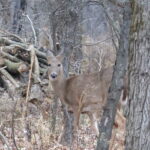
Trails are disrupted.
We quickly realized that deer, raccoons, coyotes, woodchucks, squirrels, and even chipmunks experienced a life-changing event. Their travel corridors changed as huge trees blocked deer trails, for example. They had to find new routes through the debris. One afternoon we saw a mother deer and fawn walking on the one remaining “open” trail around our prairie. Then, they crawled under a fallen tree and disappeared into the maze of branches. The ever clever raccoons have become more than pests as they tear up feeders and raid garbage cans. Also, the storm destroyed this year’s acorn and walnut crop, nuts that many species require. That is why the birds came so readily to the feeders. And still do!
-
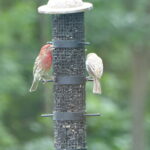
-
The house finches eat serenely.
-
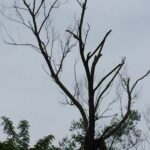
-
Even the crows come around to grab a snack.
-
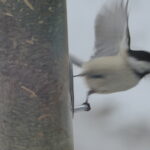
-
From early light to last dusk chickadees work the feeders.
Longer-Term Impacts
We are now watching for the long term impacts of the loss of so many trees. Our good friend, Jim Berry, is the former executive director of the Roger Tory Peterson Institute in New York. We asked him what we might expect following the loss of so many big trees in Faulkes Woods and our property.
“There are winners and losers. I would expect to see fewer wood thrushes, ovenbirds, and scarlet tanagers. They prefer mature forests. The more open woods and sunshine hitting the ground will cause an increase in cardinals, robins, and white-eyed vireos,” he said.
We have been fortunate to enjoy seven woodpecker species over the years. Some will benefit and some will lose from the great woods opening windstorm. According to Jim red-headed, red-bellied, and downy woodpeckers are likely to increase. So will flickers.
But sapsuckers and hairy and pileated woodpeckers that like the old trees and a closed canopy will probably decline.
-
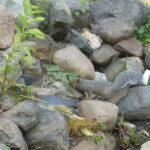
-
The small mammals are hungry.
-
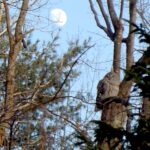
-
Owls will benefit from broken trees as cavities develop.
-
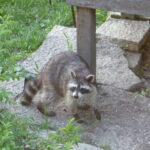
-
Raccoons ravage feeders at night.
The loss of hollow trees that shelter animals and the destroyed nut crop are going to make this a lean winter for squirrels. Deer, blue jays, woodchucks, chipmunks, and wild turkeys will also miss the acorns that normally rain down each fall.
We were saddened to lose so many trees but look forward to watching the forest restore itself. We’re also watching to see changes in wildlife.
by Winding Pathways | Sep 24, 2020 | (Sub)Urban Homesteading, Garden/Yard, Mammals, Nature
People in Eastern Iowa planting young trees to replace those shattered by the August 10 Derecho need to remember an important step. Protect those vulnerable and valuable young trees.
Here is our story. A distressing sight greeted us one September morning a few years ago as we walked to the mailbox to get the newspaper. Overnight a deer had chosen our favorite young maple tree to polish his antlers. He was thorough and had rubbed the bark off all around the two-inch diameter trunk. It was girdled and doomed.
We should have known better. Buck deer start growing their antlers in April and by about Labor Day, they are full size. Antlers are formed by a blood-rich skin called velvet. By late summer it has dried and bucks rub it off polishing up their antlers for dominance battles with rivals. By neglecting to protect our tree we gave a buck a great rubbing place. And doomed our tree to an early death.
Deer begin rubbing in early fall and sometimes continue until the deer mating season approaches in early November. Deer live in most American cities and regularly roam through suburbs. They are as happy to rub their antlers on an ornamental tree in the front yard as on one back in the woods. It’s never good for the tree.
Deer seem to prefer to rub on saplings with trunks a few inches in diameter. They especially seem to prefer pine and black cherry trees but we have even lost young spruces to their rubs. One thing is predictable. The tree that a family most treasures is the one a buck is likely to destroy.
Damage is preventable. We now run a four-foot-high circle of wire mesh around the tree and wire it to a fence post hammered securely into the ground. Once a tree reaches five or six inches in diameter deer rarely bother them, so the wire is only needed for a few years.
Be sure to water your new, young fall-planted tree. And, protect it with wire mesh.
-
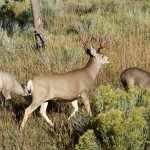
-
With polished antlers, this muledeer buck proudly strode across the meadow. Whitetails are more common in the East and Midwest. “Mulies” are common in the High Plains and west.
-
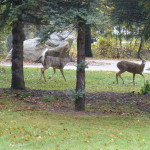
-
On Halloween day a buck was hot on the “tail” of this doe and yearling.
-
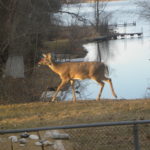
-
Deer in yard.

























